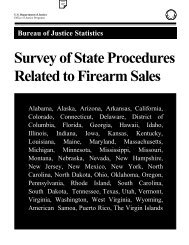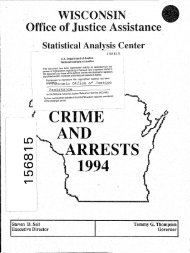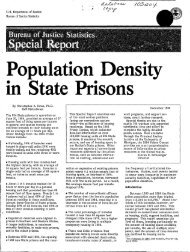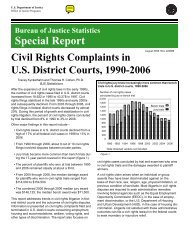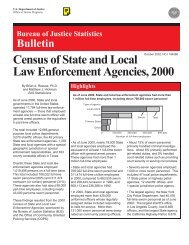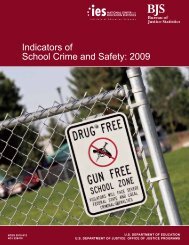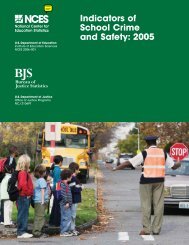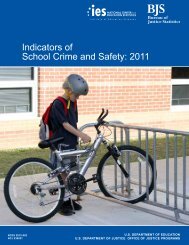Sourcebook of Criminal Justice Statistics, 1983 - Bureau of Justice ...
Sourcebook of Criminal Justice Statistics, 1983 - Bureau of Justice ...
Sourcebook of Criminal Justice Statistics, 1983 - Bureau of Justice ...
You also want an ePaper? Increase the reach of your titles
YUMPU automatically turns print PDFs into web optimized ePapers that Google loves.
----------- -- ~<strong>Sourcebook</strong> <strong>of</strong> <strong>Criminal</strong> <strong>Justice</strong> <strong>Statistics</strong> <strong>1983</strong>Public Attitudes Toward Crime and <strong>Criminal</strong> <strong>Justice</strong>-Related TopicsTable 2.24 Respondents reporting whether they would tend toovoid groups <strong>of</strong> teenagers on the street, by demographiccharacteristics, United States, 1982!\oTE: See !\oTE, Table 2.1. For a discussion <strong>of</strong> public opinion surveysampling procedures, see Appendix 7. For detailed information onthis survey, see Appendix 8.Question: "If you sow a group <strong>of</strong> teenagers on a street cornerwould you tend to ovoid walking post them or not?"NotionalSex:MoleFemaleRoce, ethnicity:WhiteBlockHispanicEducation:CollegeHigh schoolGrode schoolEmployment status:Full-time employedPort-time employedUnemployedLaid <strong>of</strong>fRetiredFull-time homemakerStudentIncome:30,000 and over20,000 to $29,99912,000 to $19,99918,000 to $1 1,999Under $8,000Age:18 to 24 years25 to 29 years30 to 49 years50 to 64 years65 years and olderComnunity size:Lorge citySuburbSmall townRuralRegion:NortheastMidwestSouthWest(Percent a )Neighborhood racial characteristics:Mostly or all whiteRacially mixedMostlj' or all blockNeighborhood age structure:Mostly younger than 35 yearsMostly between 35 and 55 yearsMostly older than 55 yearsMixed, all agesNo opinion,Would Would nOT refusedovoid ovoid to answer40275H39465136435335404436485741323941524939423542515238373642403839384750373841415972416052496356446459556449405967605746496057655646476162625759605961524761625758Opercents may not odd to 100 due to rounding.Source: Table constructed by sa..RCEBOO< st<strong>of</strong>f from dataprovided by the ABC News Poll; data were ma"de available throughthe <strong>Criminal</strong> <strong>Justice</strong> Archive and Information Network, InteruniversityConsortium for Political and Social Research.I3oI22IIIo32oII2I2IIII32II2II22II32I2ITable 2.25 Attitudes toward statements about juvenile crime, UnitedStates, 1982!\oTE: The data below are from a telephone survey <strong>of</strong> 1,002 persons 18 years<strong>of</strong> age and older living in private households in the continental UnitedStates. The survey was conducted by the Opinion Research Corporationduring the period between Mar. 26, 1982 and Apr. 5, 1982.Question: ''Now I'm going to read you a series <strong>of</strong> statements aboutjuvenile crime. I'd like you to tell me whether you agree strongly, agreesomewhat, disagree somewhat, or disagree strongly with each <strong>of</strong> thesestatements."The rooin purpose <strong>of</strong> the juvenilecourt system should be to treatond rehabilitate rather than punishThe juvenile courts are too lenienton juveniles found guilty <strong>of</strong> seriouscrimesT"ere has been a steady andalarming increase in the rate<strong>of</strong> serious juvenile crimeComnitting juveniles to correctionalinstitutions serves as a deterrentto other youths from conmittingcrimesYouths who ore runoways, habitualtruants, and youths in conflict withtheir parents should not be hondledby the juvenile court system, butby other conmunity agenciesIncreosing employment opportunitiesfor youths could prevent a lot <strong>of</strong>serious crimesThe juvenile crime problem is notreally as serious as most peopleare saying it isNot enough money and resourcesare being spent on trying toprevent crimes by juvenilesAgree Agree Disagree Disagreestrongly somewhat somewhat strongly45 28 13 1052 26 563 24 523 34 20 1630 31 18 1267 22 5 46 9 20 6135 26 15 10Opercents do not total 100 because the "no opinion" and "no response"alternatives were excluded.Source: Hubert H. Humphrey Institute <strong>of</strong> Public Affairs, Publ icAttitudes Toward Youth Crime, Working paper (Minneapolis, Minn.: HiDertH. Humphrey Institute <strong>of</strong> Public Affairs, 1982). Table adopted bySc:l..RCEBOO< st<strong>of</strong>f. Reprinted by permission.-- JTable 2.26 Attitudes toward the statement that the moin purpose <strong>of</strong> the juvenile court system should betreatment and rehabilitation, by demographic charact~ristics, United States, 1982NJTE: See !\oTE, Table 2.25. The States comprising each region are as follows: Northeast--Connecticut, Moine,Massachusetts, New Hampshire, New Jersey, New York, Pennsylvania, Rhode Island, Vermont; North Central--Illinois,Indiana, Iowa, Kansas, Michigan, Minnesota, Missouri, Nebraska, North Dakota, Ohio, South Dakota, Wisconsin; South-Alabama, Arkansas, Delaware, District <strong>of</strong> Columbia, Florida, Georgia, Kentucky, Louisiana, Maryland, Mississippi, NorthCarolina, Oklahoma, South Carolina, Tennessee, Texas, Virginia, West Virginia; West--Arizana, California, Colorado,Idaho, Montano, Nevada, New Mexico, Oregon, Utah, Washington, Wyaming.Question: "I'd like you to tell me whether you agree strongly, agree somewhat, disagree somewhat, or disagreestrongly with each <strong>of</strong> the statements.""The main purpose <strong>of</strong> the juvenile court system shOUld be to treat and rehabilitate rather than punish."TotalSex:MoleFemaleRace:'.... hlteBlock! otherEducation:High school, incompleteHigh school, graduateCollege, incompleteCollege, graduateOccupation:Pr<strong>of</strong>essional, manager, ownerSoles ond clericalBlue collarHousehold income:Under $15,000$15,000 to $24,999$25,000 and over$25,000 to $34,999$35,000 and overAge:Under 35 years18 to 24 years25 to 34 years35 to 44 years45 to 64 years65 years and olderComnunity size:NonmetroMetro:50,000 to 999,9991,000,000 and overRegion:North':lostNorth CentralSouthWestI-klme ownership:OwnRentHousehold size:I or 2 people3 or 4 people5 people and mareMarital status:MarriedNot marriedEmployment status:EmployedEmployed femaleNot employedNot employed femaleHead <strong>of</strong> household:MoleFemaleNumber <strong>of</strong>respondents1,0024995038711231673571902852921202212372153972521454291472821812461335513411102192603311927022%4414081486583416402653622384321~40(Percent)Agreestrongly45424844524744484342414847474343454445434847if I4545424348415145464542524545444647494248Agreesomewhat28302629262525303231332229272931253130322425302927282632292427302831212632292628273026Disagreesomewhat131312138II1481415131210151415131314131213II13121212121410131213121313121314II91312DisagreestronglY10II91010II1210810101387II101287913IIII9II141751010II81010II127IIII97129No opinion!no responseSource: Hubert H. Humphrey Institute <strong>of</strong> Public Affairs, Public Attitudes Toward Youth Crime, Working paper(Minneapolis, Minn.: Hubert H. Humph~ey Institute <strong>of</strong> Public Affairs, 1982). Table adopted by SOLRCEBOO< st<strong>of</strong>f.Reprin~ed by permission.-.,445446543235643I544334745423654445344335835




